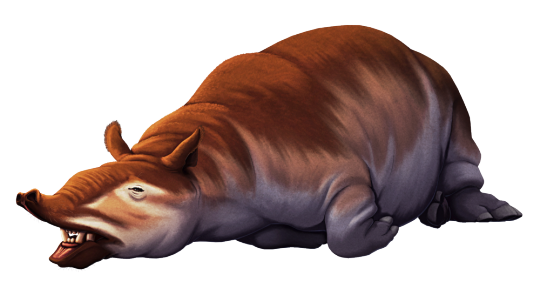#cadurcodon
Explore tagged Tumblr posts
Text

Cadurcodon ardynensis was an odd-toed ungulate that lived in what is now Mongolia during the late Eocene, about 37-34 million years ago.
It was around 2m long (6'6") and, despite its very tapir-like appearance and lack of horns, it was actually closer related to modern rhinoceroses – it was part of a group of early rhino-cousins known as amynodontids, which convergently evolved both hippo-like and tapir-like lifestyles.
Cadurcodon was the most tapir-like of the tapir-like amynodontids, with a short deep skull and retracted nasal bones that indicate it had a well-developed prehensile trunk. Males also had large tusks formed from their upper and lower canine teeth, which may have been used for fighting each other.
———
NixIllustration.com | Tumblr | Patreon
References:
Averianov, Alexander, et al. "A new amynodontid from the Eocene of South China and phylogeny of Amynodontidae (Perissodactyla: Rhinocerotoidea)." Journal of Systematic Palaeontology 15.11 (2017): 927-945. https://doi.org/10.1080/14772019.2016.1256914
Громова, В. [Gromova, V.] Болотные носороги (Amydontidae) Монголии. [Swamp rhinoceroses (Amynodontidae) of Mongolia.] Trudi Paleontol. Inst., Akad. Nauk SSSR 55:85-189 (1954) https://www.geokniga.org/books/13983
Prothero, Donald R., and Robert M. Schoch. Horns, tusks, and flippers: the evolution of hoofed mammals. JHU Press, 2002. http://www.rhinoresourcecenter.com/pdf_files/141/1415340780.pdf
Wall, William P. "Cranial evidence for a proboscis in Cadurcodon and a review of snout structure in the family Amynodontidae (Perissodactyla, Rhinocerotoidea)." Journal of Paleontology (1980): 968-977. https://www.jstor.org/stable/1304363
Wikipedia contributors. “Amynodontidae.” Wikipedia, 17 Dec. 2023, https://en.wikipedia.org/wiki/Amynodontidae
Wikipedia contributors. “Ergilin Dzo Formation.” Wikipedia, 12 Feb. 2024, https://en.wikipedia.org/wiki/Ergilin_Dzo_Formation
#science illustration#paleontology#paleoart#palaeoblr#cadurcodon#amynodontidae#rhinocerotoidea#stem-rhino#perissodactyla#ungulate#mammal#art#he just woke up
274 notes
·
View notes
Text

Another #paleostream sketch
This is Cadurcodon, a curious creature. It looks similar to a tapir, but is actually a hornless rhino.
209 notes
·
View notes
Note
Have we figured out what Macrauchenia was doing with its nose, if it didn't have that trunk it's usually depicted with?
We have not. The most recent primary source I could find, Wall 1980, claims ��the posterior placement of the nasal incision and nasal bones, and the presence of large snout muscle scars behind the external nares” supports the trunk. Those who oppose the trunk argument argue there’s no bony support for the trunk, as most trunked mammals have a little dorsal projection of the nostril - but Pyrotherium, Cadurcodon, and this astrapothere barely have anything. In my relatively uninformed opinion, I see some sites on the skull that might be attachment points for weird musculature. I don’t know if anyone’s reconstructed it recently.

And it looks like a messed-up cetacean.
52 notes
·
View notes
Text




Results from the #paleostream!
Cadurcodon (a trunked rhino), Otoceras, Pangerpeton and Ninoziphius (the whale)
#paleoart#sciart#rhino#ammonite#beaked whale#whale#gharial#pisco formation#salamander#palaeoblr#paleostream
404 notes
·
View notes